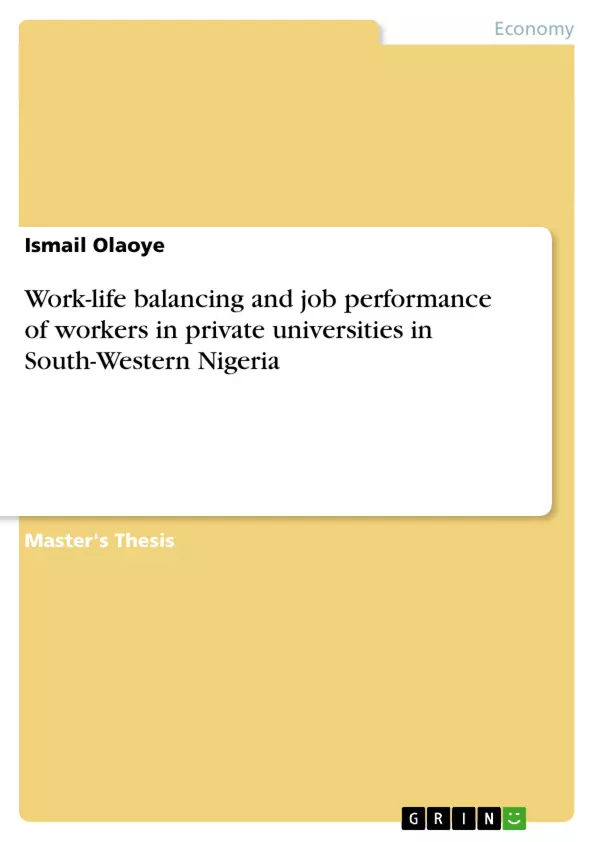This study identified existing organizational practices and policies helping to balance work and life roles among workers and examined the factors that inhibit or enhance their adoption by workers in South-Western Nigeria. It also investigated the relationship between work-life balance and performance of workers, with a view to gaining an understanding of the range of ways by which workers in Nigeria achieve work-life balance.
The study was conducted in six purposively selected private universities across the six states of South-western Nigeria, using primary and secondary data. A sample size of 540 was derived from a total of 702 using stratified sampling technique. Questionnaires were administered to all the respondents to ferret information on work-life balance and performance of workers. Secondary data from institutional records were used to augment information gathered through the questionnaire. Data collected were analyzed using frequency cross-tabulation, correlation and regression analysis.
Organizational policies such as the provision of crèche, staff school, staff club, recreational centres, staff canteen and annual family get together were identified as locally adopted practices by staff. The study found that the existence of these organizational policies and practices is positively correlated with available variation of such policies and practices (r=0.859; p>0.01), use or adoption of such policies and practices (r=0.898; p>0.01) and the perception of a balanced work and life interaction (r=0.184; p>0.01). Personal perception of a balanced work-life is also positively and significantly correlated with all the other factors; availability of variations (r=0.144; p>0.01) and adoption of these policies and practices (r=0.166; p>0.01). A fairly low Durbin-Watson score of 1.366 indicates that the availability of any other Work-Life balancing factor, such as flexible working, could dramatically affect the outcome of the study. It also confirmed the hypothesis that there is no relationship between adoption of work-life balance policies or practices and performance.
Summarily, there is the need for the expansion of work-life balancing practices to include such practices as flexible working, tele-working, job-sharing, paternity leave, multiple tranches maternity leave and the simpler breast feeding break and that undergraduate HRM curriculum should include work-life balancing concepts to expand the scope of enquiries into their features and evolutions.
Inhaltsverzeichnis (Table of Contents)
- CHAPTER ONE
- INTRODUCTION
- Background to the Study
- Statement of the Problem
- Objectives of the Study
- Research Hypotheses
- Justification for the Study
- Scope and Limitation of the Study
- Operational Definition of Terms
- CHAPTER TWO
- LITERATURE REVIEW
- Concepts of Work
- Concepts of Life
- Work-Life Conflict
- Work-Life Balance
- Work-life Balance, Ethics and Social Responsibility
- Work-life Balance, Performance and ICT
- Empirical Evidences from other countries
- Work-Life Balance Policy Foundation
- Evidences from Nigeria
- Motivational Background to Work-life Balance
- Theories of work-life Balance
- Theoretical Framework
- Conceptual Framework for analysis
- CHAPTER THREE
- METHODOLOGY OF RESEARCH
- Study Area
- Research Design
- Sample Size and Sampling Procedure
- Sources and Collection of Data
- Research Instruments
- Measurement of Variables
- Data Analysis Techniques
- CHAPTER FOUR - DATA PRESENTATION, ANALYSIS AND INTERPRETATION
- Socio-economic information
- Work Interference with Personal Life (WIPL)
- Personal Life interference with Work (PLIW)
- Work and Personal Life Enhancement
- Organizational Policies and Practices Helping To Balance Work and Life Roles
- Factors Influencing the Adoption of Work-Life Balancing Policies and Practices
- Relationship between Work-Life Balancing and Job Performance
Zielsetzung und Themenschwerpunkte (Objectives and Key Themes)
The study aims to assess the relationship between work-life balancing and job performance among workers in private universities in South-Western Nigeria. The research investigates the impact of work-life balance on job performance, considering various factors such as personal life interference, work-life enhancement, organizational policies, and other influencing factors.
- Work-Life Balance in Private Universities
- Factors Affecting Work-Life Balance
- Impact of Work-Life Balance on Job Performance
- Organizational Policies and Practices for Work-Life Balance
- Motivational Theories and Frameworks
Zusammenfassung der Kapitel (Chapter Summaries)
The first chapter introduces the study's background, problem statement, objectives, hypotheses, justification, scope, and operational definitions. The second chapter presents a comprehensive review of literature on work-life balance, conflict, and related concepts. It examines empirical evidence from other countries and Nigeria, explores motivational theories, and outlines the theoretical framework for the study. The third chapter details the research methodology, including study area, design, sample size, data collection techniques, instruments, and analysis methods. The fourth chapter presents the data analysis and interpretation, covering socio-economic information, work-life interference, personal life interference, work and personal life enhancement, organizational policies and practices, and the relationship between work-life balancing and job performance.
Schlüsselwörter (Keywords)
This thesis examines the relationship between work-life balancing and job performance in private universities in South-Western Nigeria. Key themes include work-life balance, work-life conflict, job performance, organizational policies and practices, motivational theories, and empirical research findings.
- Citation du texte
- Ismail Olaoye (Auteur), 2012, Work-life balancing and job performance of workers in private universities in South-Western Nigeria, Munich, GRIN Verlag, https://www.grin.com/document/267275



